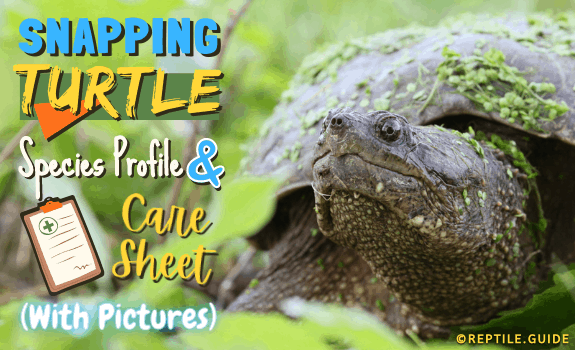Snapping turtles are one of the most well-known species in the Americas. They’re famous for their prehistoric appearance and spunky personality.
Daredevil turtle enthusiasts may be tempted to bring a snapping turtle home (especially if it’s a cute baby snapping turtle). But their enormous size and testy personality call for a dedicated and experienced keeper.
Keep reading to learn about the biology and care needs of these modern dinosaurs.
In This Article
Facts at a Glance
|
Common Name |
|
|
Scientific Name |
|
|
Adult Size |
Chelydra spp.: Carapace (upper shell): 9.8 – 20 in. (24.9 – 50.8 cm) Weight: 9.9 – 35.3 lbs. (4.5 – 16 kg) Macrochelys spp.: Carapace (upper shell): 13.8 – 31.8 in. (35.1 – 80.8 cm) Weight: 19 – 176 lbs. (8.6 – 79.8 kg) |
|
Native Range |
As far South as Ecuador in South America As far North as Manitoba, Canada As far West as New Mexico, United States As far East as Nova Scotia, Canada |
|
Lifespan |
100+ Years |
|
Natural Diet |
Fish, amphibians, reptiles, waterfowl, crustaceans, small mammals, carrion, and aquatic plants |
|
Natural Habitat |
Slow-moving rivers, swamps, ponds, streams, tributaries, estuaries, and wetlands with murky fresh or brackish water. |
|
Do They Make Good Pets? |
No (only for experts) |
|
Minimum Enclosure Dimensions |
6 inches per 1 inch of shell length Length x Width x Height: Chelydra spp.: 3 x 2 x 1.5 feet (1 x 0.5 x 0.5 meters) Macrochelys spp.: 6 x 2 x 2 feet (1.75 x 0.5 x 0.5 meters) |
|
Temperature |
75 – 85°F (23.8 – 29.4°C) |
Snapping Turtle Native Range and Habitat
Snapping turtles prefer to live in water bodies with muddy bottoms and dense vegetation. They frequently bury their shell and leave their head exposed to forage in camouflage.
Their range is extensive, spanning most of North America.
In Canada, the Common Snapping Turtle (Chelydra serpentina) lives in:
- Ontario
- Quebec
- Manitoba
- Nova Scotia
- Saskatchewan
- New Brunswick
In the United States, common snapping turtles occupy every continental state. They’re native to all of the central and eastern states.
The Central American Snapping Turtle (Chelydra rossignonii) lives in:
- Belize
- Mexico
- Honduras
- Guatemala
The South American Snapping Turtle (Chelydra acutirostris) inhabits:
- Ecuador
- Panama
- Colombia
- Honduras
- Nicaragua
- Costa Rica
Alligator Snapping Turtles (Macrochelys spp.) have a more restricted range focused around the Gulf of Mexico, including:
- Texas
- Illinois
- Florida
- Indiana
- Kansas
- Missouri
- Georgia
- Alabama
- Kentucky
- Arkansas
- Louisiana
- Oklahoma
- Mississippi
- Tennessee
Conservation
The International Union for the Conservation of Nature (IUCN) currently lists the Common Snapping Turtle as a species of least concern.
The IUCN lists the Alligator Snapping Turtle as a threatened species. It also receives protection as a listed CITES III species, which limits exportation.
Alligator Snappers are endangered and have state-level protections in:
- Illinois
- Indiana
- Missouri
- Kentucky
Florida Snapping Turtle
A Florida snapping turtle may be any of four species:
- Common Snapping Turtle (Chelydra serpentina)
- Alligator Snapping Turtle (Macrochelys temminckii)
- Suwannee Snapping Turtle (Macrochelys suwanniensis)
- Apalachicola Snapping Turtle (Macrochelys apalachicolae)
The Apalachicola River Snapping Turtle is a proposed new species. They live in the Apalachicola River region. This river spans through the panhandle of Florida.
The Suwannee Snapping Turtle is a new species that lives in the Suwannee River region. The Suwannee River runs through Southern Georgia and Northern Florida.
Both the Common Snapping Turtle and the Alligator Snapping Turtle inhabit the whole state of Florida.
As long as you know what you’re looking for, it’s easy to identify them.
Common Snapping Turtles:
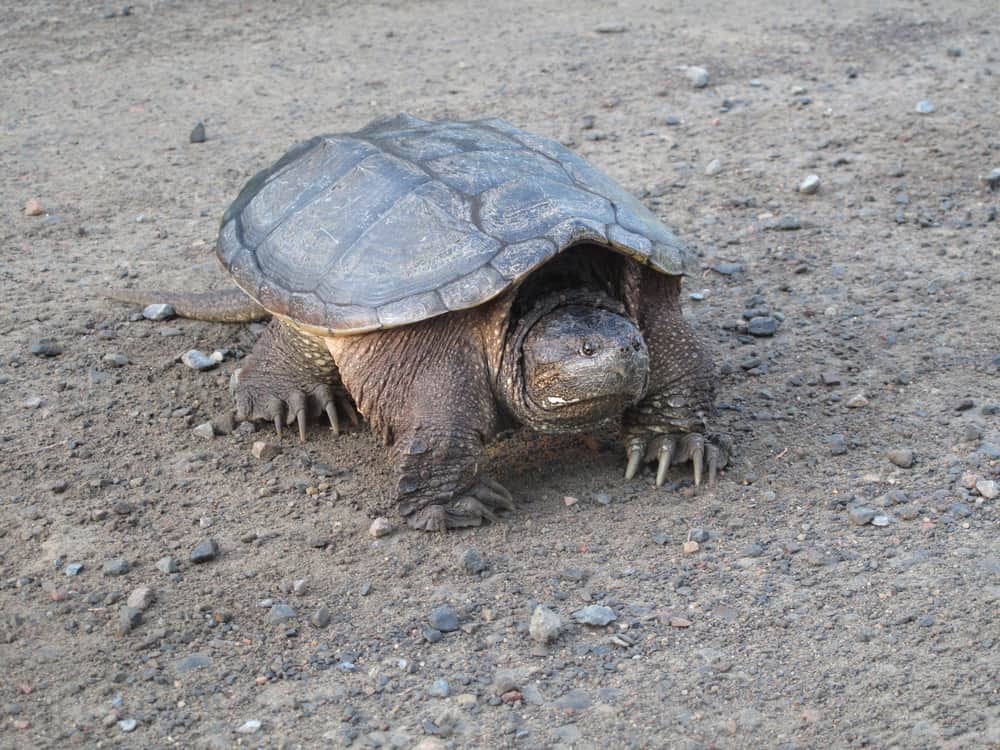
- Oval head
- Smooth shell
- Rounded beak
- Smaller size (max 20 in, 75 lb)
Alligator Snapping Turtles:
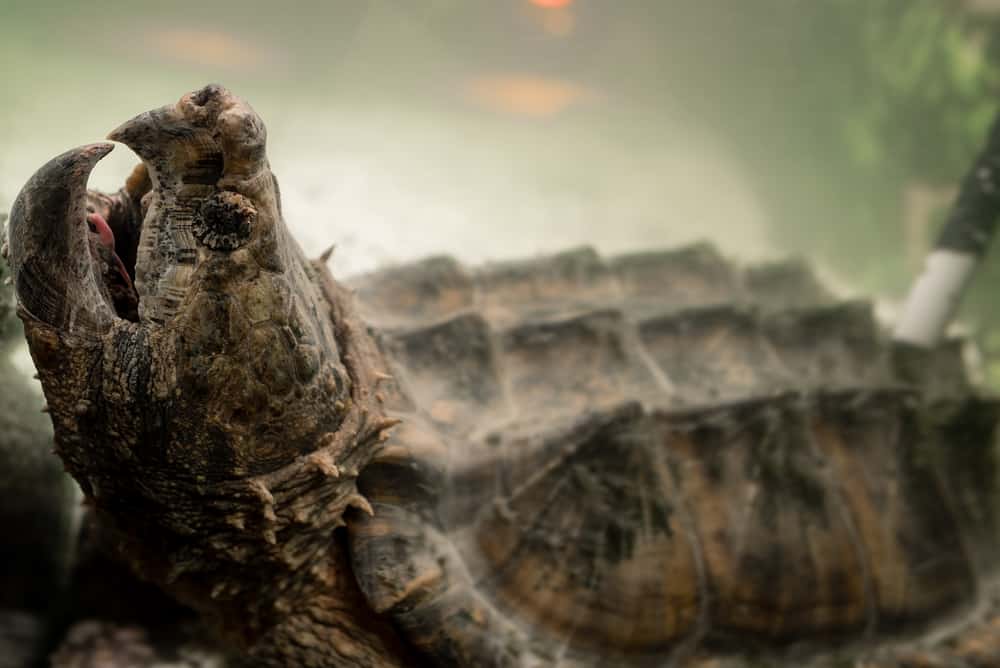
- Hooked beak
- Rough, bumpy shell
- Triangular, pointy head
- Three keeled ridges on carapace
- Fleshy ‘eyelash-like’ growths around eyes
- Red, fleshy worm-like lure inside the mouth
Snapping Turtle Michigan
There is only one species of snapping turtle in Michigan: the Common Snapping Turtle. It’s also the largest species in the state.
Some localized areas have experienced significant habitat loss and population declines. Overall, the common snapping turtle is well-established with healthy populations in Michigan.
Snapping Turtle NC
There is only one species of snapping turtle in NC: the Common Snapping Turtle. They’re the largest freshwater turtle in the state.
They live across the whole state. They’re thriving as a species, with healthy populations.
Snapping Turtle Texas
Common Snapping Turtles and Alligator Snapping Turtles both live in Texas.
There’s a healthy, thriving population of Common Snapping Turtles across all of Texas. They have no special protections.
Alligator Snapping Turtles are endangered in Texas. They have state protections from hunting and collection. Their range in Texas is limited to the eastern-most counties.
Snapping Turtle Size and Appearance
Snapping turtles are among the most prehistoric-looking reptiles in existence. Like dinosaurs, they’re huge and covered in tough, armor-like skin and scales.
You may wonder: Just how huge?
Chelydra spp.:
Carapace (top shell): 9.8 – 20 in. (24.9 – 50.8 cm)
Weight: 9.9 – 35.3 lbs. (4.5 – 16 kg)
Macrochelys spp.:
Carapace (top shell): 13.8 – 31.8 in. (35.1 – 80.8 cm)
Weight: 19 – 176 lbs. (8.6 – 79.8 kg)
They also have long claws (very sharp) and long tails. Their neck is elongated and flexible. This adaptation allows them to snap at unexpected angles.
Chelydra and Macrochelys species both have a hard beak and powerful muscles. They snap quickly and powerfully.
Chelydra species have a rounded beak (mouth), while Macrochelys species have a triangular beak with a dangerous hook.
Macrochelys species have additional fleshy growths extending from around their eyes, as well as in their mouth.
All species of snapping turtle are naturally drab. They may be black, brown, or even green-tinged from algae.
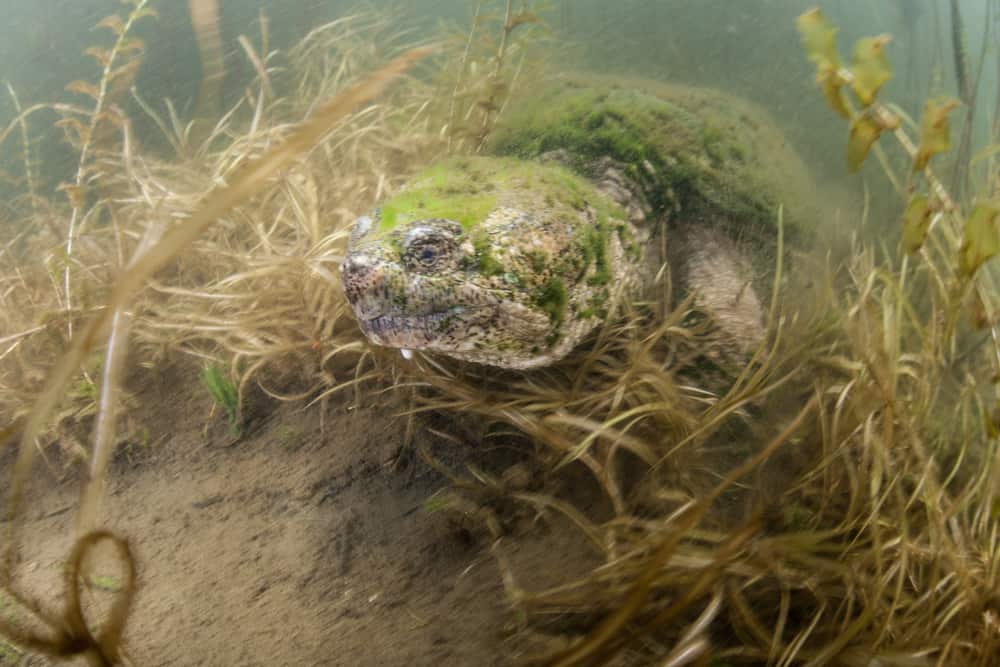
They’ve adapted to blend in with mud and aquatic vegetation.
Albino Snapping Turtle
The Albino Snapping Turtle is the singular exception to the rule of drabness. It tends to be pink or white, and stands out rather than blending in.
Albino Snapping Turtles wouldn’t survive very long in the wild.
Helpless, tiny hatchlings rely on camouflage to avoid being eaten by predators. Hungry carnivores would immediately scoop up tiny, white turtles.
In captivity, on the other hand, breeders have worked on developing an albino morph for over twenty years. Albino Common Snapping Turtle babies sell for over $4,000!
Snapping Turtle Shell
The snapping turtle shell is rough, bumpy, and sometimes keeled.
The extreme textures are much more apparent in Macrochelys species. Young Chelydra species may also be bumpy, but they tend to smoothen with age.
Snapping Turtles can partially retract their head and limbs under their carapace (top shell). Unlike other turtles, their plastron (bottom shell) is smaller than their body.
Pictures of Snapping Turtles
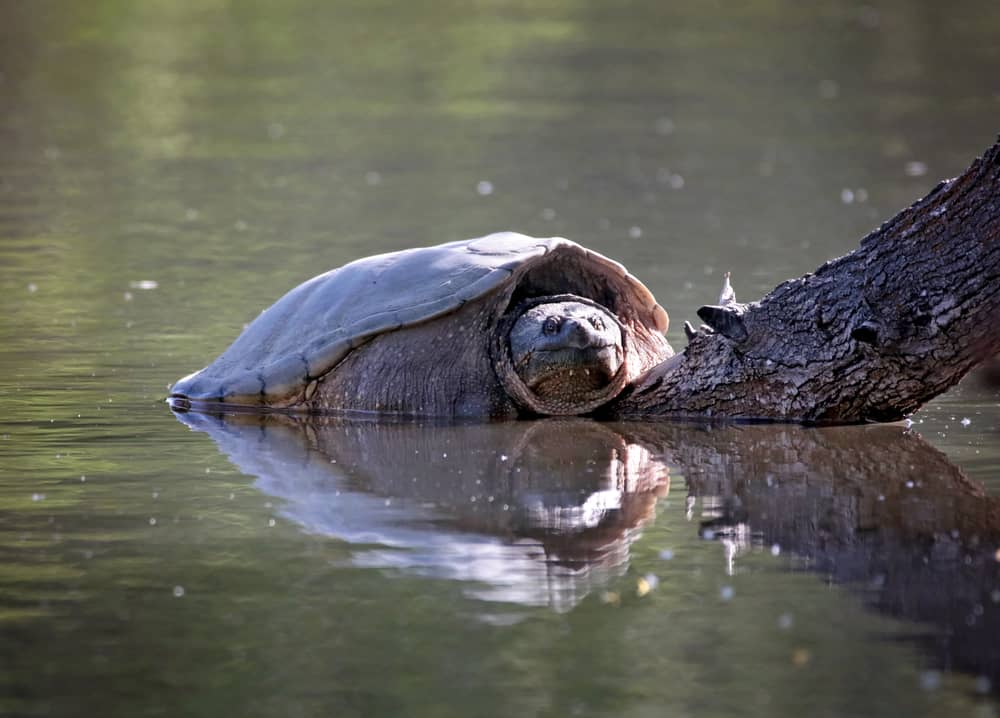
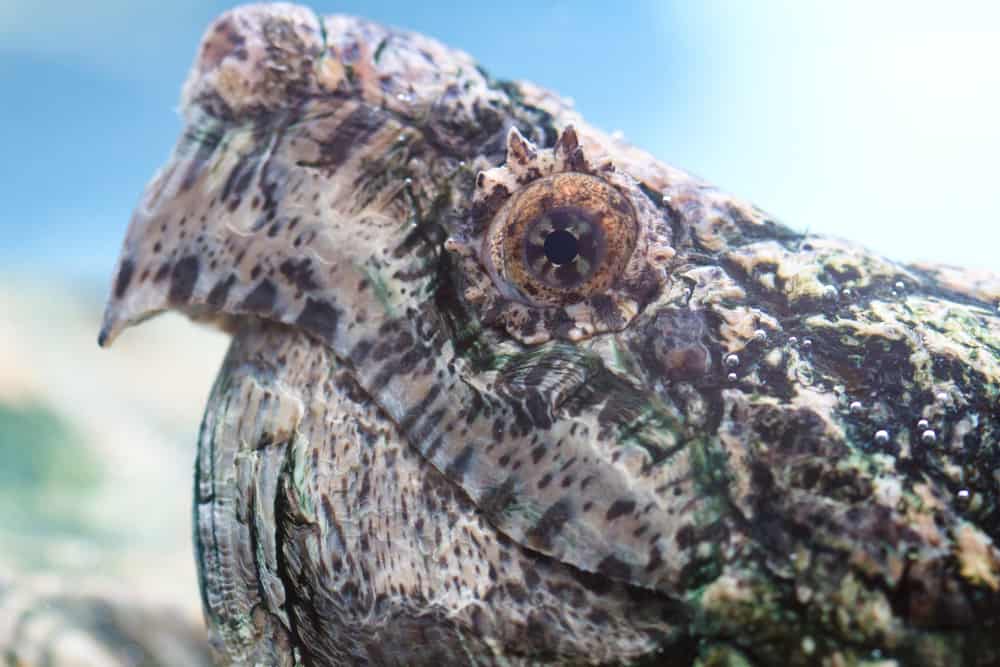
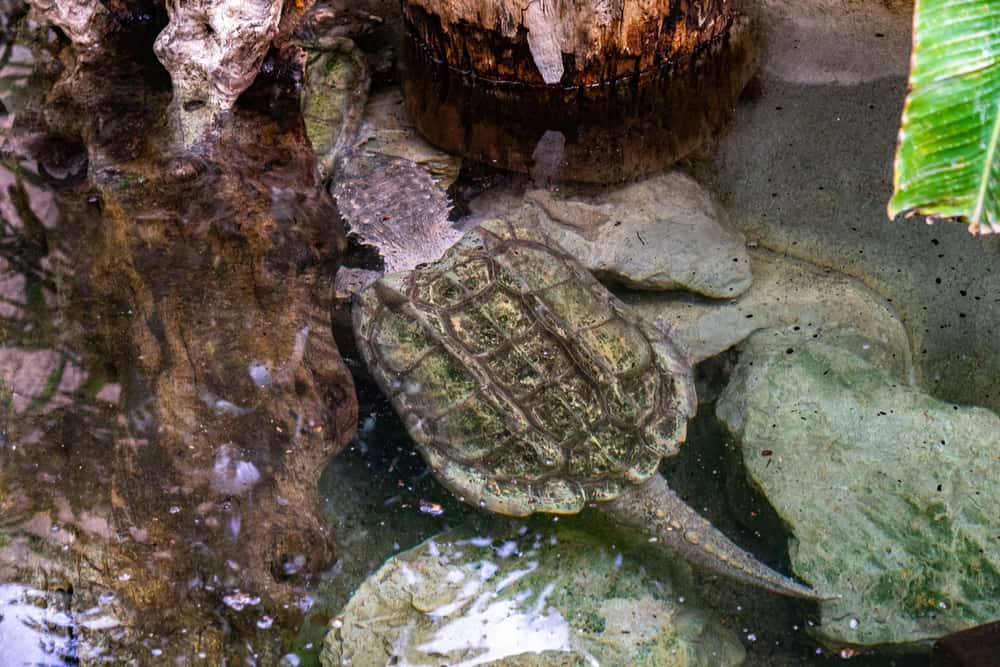
Are you looking for more pictures of snapping turtles? Many avid reptile-lovers upload photos of their wild findings to .
Their pages for Common Snapping Turtles and Alligator Snapping Turtles feature plenty of beautiful, engaging, and even amusing photos of wild snapping turtles.
Snapping Turtle Temperament and Behavior
Snapping turtles are well-known for their bad attitude and willingness to bite.
Turtle enthusiasts know that there’s more to these turtles than their namesake self-defense maneuvers.
Biting and Self-Defense
We get it: snapping turtles snap. They also hiss really loud.
Underwater, snapping turtles almost always swim or ‘run’ away from dangerous situations.
On land, they feel much more vulnerable. They’re unable to take flight, so they must fight.
Unsurprisingly, their vulnerability means that they’re almost always ready and willing to take a chomp out of any perceived threat.
People often exaggerate the Snapping turtle’s “powerful jaws” strength.
Alligator Snapping Turtles bite with 158 N of force.
Common Snapping Turtles bite with 208 N of force.
The strongest turtle, the Common Toad-Headed Turtle, bites with 432 N of force.
For comparison purposes, humans can bite with 200 to 600 newtons (N) of force between their second molars.
Still, the bite of a snapping turtle is nothing to trifle with. They move quickly, and their hard beaks are designed for shearing and slicing flesh.
Diet
Snapping turtles are primarily carnivorous. Their diet consists mainly of:
- Fish
- Carrion
- Reptiles
- Waterfowl
- Amphibians
- Crustaceans
- Invertebrates
- Small mammals
Snapping turtles aren’t picky. They’ll eat anything that passes by as long as they can overcome it.
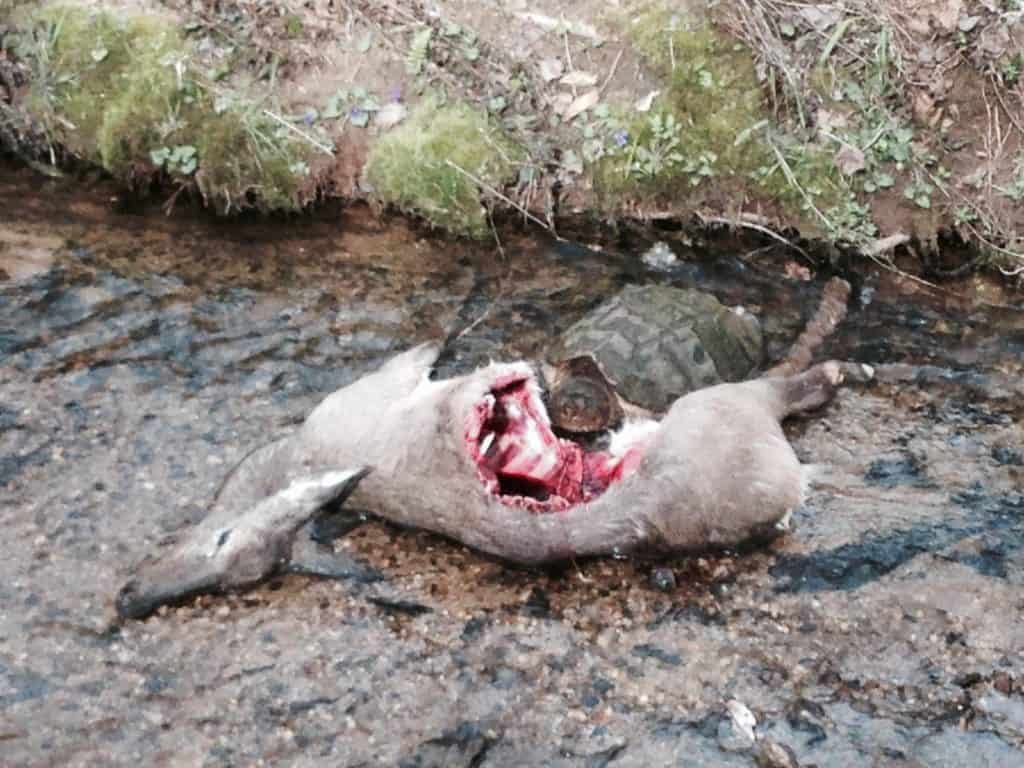
They’ll even tear chunks of meat from large rotting carcasses, such as deer.
Plants also make up a small portion of their diet, perhaps about one-third of it:
- Algae
- Moss
- Leaves
- Duckweed
- Water lettuce
A Common Snapping Turtle’s diet is more varied and omnivorous, while Alligator Snapping Turtles consume a more meat-based diet.
Hibernation
Northern snapping turtles burrow into the mud to hibernate during the winter, and become active again as soon as the surface ice melts.
In some regions, that means snapping turtles may remain buried in mud for over six months!
Hibernating snapping turtles can obtain oxygen through the water.
They have specialized membranes in their mouths, throats, and cloacae (anus and sexual opening) that allow for aquatic gas exchange.
These methods, known as buccopharyngeal pumping and cloacal respiration, likely account for 5 – 31% of a snapping turtle’s total oxygen consumption.
Significance in the Ecosystem
It’s unlikely that snapping turtles have any significant impact on fish or waterfowl populations.
Unfortunately, fishermen and farmers often believe these false myths and remove snapping turtles from prime aquatic habitats.
Snapping turtle eggs and babies are an essential food source for many small to medium carnivores and scavengers:
- Foxes
- Coyotes
- Raccoons
- Opossums
- Birds of prey
How to Pick Up a Snapping Turtle
- Approach the turtle from behind.
- Grasp the back of the turtle’s carapace (top shell) with one hand on each side.
- Lift the turtle and quickly transport it to its intended destination.
- Gently but quickly place the turtle on the ground and back away.
- NEVER lift a snapping turtle by its tail. Doing so can severely injure the turtle.
Snapping Turtle Lifespan
Common Snapping Turtle (Chelydra spp.) Lifespan – Wild: 30 Years
Common Snapping Turtle (Chelydra spp.) Lifespan – Captivity: 50 Years
Alligator Snapping Turtle (Macrochelys spp.) Lifespan – Wild: 45 Years
Alligator Snapping Turtle (Macrochelys spp.) Lifespan – Captivity: 70 Years
Oldest Snapping Turtle: Thunder, the alligator snapping turtle that lived at the Newport Aquarium. She was estimated to be 150 years old.
Pet Snapping Turtle
For average turtle lovers, snapping turtles do not make good pets.
They require huge enclosures, live for 30-50+ years, and will always be dangerous.
While some captive snapping turtles may become calm, not all will. They’ll always be wild animals with a dangerous bite.
For the committed keeper, snapping turtles can make a rewarding and unique pet.
Before you decide to get a snapping turtle, be sure you have the space, funds, and time that this behemoth requires.
Snapping Turtle Husbandry
Aside from enclosure size, husbandry is likely the most straightforward aspect of snapping turtle ownership.
Supply List
- Pond water heater
- Aquarium water test kit
- Aquarium water conditioner
- Powerful pond or canister filter.
- Basking heat lamp and lightbulb
- Basking UVB lamp and lightbulb
- Basking surface, i.e., large log or shelf
- A large enclosure that holds water (at least 2’ x 3’ x 2’ for an adult)
- Well-fitted, locking enclosure lid
Enclosure Size and Style
Adult Minimum Enclosure Dimensions: 3’ x 2’ x 1.5’ (1 x 0.5 x 0.5 meters)
Anything that has the correct dimensions and can hold water makes a suitable enclosure, including:
- DIY pond
- Aquariums
- Stock tanks
- Plastic kiddie pool
- Plastic storage tubs
- Preformed pond liners
Snapping turtles are excellent climbers. Be sure to buy or craft a tight-fitting, lockable lid.
The water should only be deep enough for your snapping turtle to lay on the ground and still reach the surface when fully extending its neck.
Snapping turtles grow to variable sizes and start life as tiny hatchlings. The primary consideration is to provide at least six inches of floor space for every inch the turtle grows.
Heating and Lighting
Lighting Cycle: 12 Hours On/12 Hours Off
Ideal Daytime Basking Temperature: 80-85°F (26.7-29.4°C)
Ideal Water Temperature: 75-78°F (23.9-25.6°C)
Utilize a low-output fluorescent bulb that’s specifically designed to supply UVB to reptiles. Situate the fixture at least 12 to 18 inches over the water’s surface and dry basking area.
Replace the UVB bulb every six to twelve months, even if it’s still lighting up.
Use a light reflector dome with a halogen light bulb to supply heat and UVA in the same area. This area is known as the ‘basking area’ or ‘basking zone.’
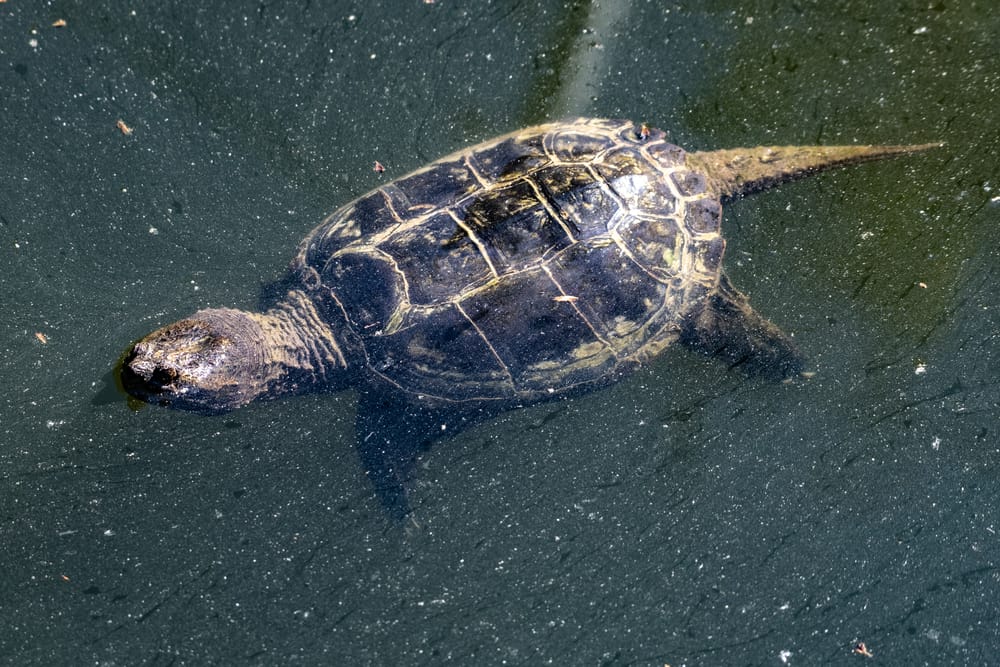
Always run your heat lamp on a dimmer switch or, preferably, a dimming thermostat. Ensure that the temperature in the habitat doesn’t climb above 85°F.
Remember to turn off both lights after 12 hours. Excessive artificial daytime hours will stress your pet. Alternatively, you can install them on an automatic timer.
If needed, heat the water with an appropriately-sized, horizontally-mounted aquarium heater that:
- Includes an internal thermostat
- Is shatterproof or comes with a guard
Water Quality
Use an aquarium water testing kit to test the water every month.
Snapping turtles are hardy and capable of temporarily living in poor conditions, but prolonged exposure will eventually result in illnesses.
Ideal Parameters:
Ammonia: 0 ppm
Nitrites: 0 ppm
Nitrates: <40 ppm
pH: 6.5-7
A powerful external canister filter is an absolute must for keeping a snapping turtle’s tank clean. Aim for a filter that’s rated for two to three times the size of the actual enclosure.
Perform water changes weekly or whenever the ammonia, nitrites, or nitrates climb too high.
Decor and Environmental Enrichment
The most crucial piece of furniture in a snapping turtle’s enclosure is an area of dry land or a basking platform.
Most snapping turtles won’t leave the water, but it’s vital they have the opportunity to do so if they want.
Commercial turtle platforms and floating logs work well for babies. You’ll need to improvise and even become crafty as your snapping turtle becomes heavier.
Adult females may need a nesting box or dig area if they develop unfertilized eggs. Like chickens, some female reptiles will develop eggs without the presence of a male.
Your snapping turtle will enjoy the addition of aquarium caves, hides, and fake plants. Hatchlings are particularly nervous and prefer to remain under cover.
Be prepared for larger snapping turtles to destroy almost anything you add to their habitat. That’s not a bad thing; as long as it’s safe – it’s enrichment!
Substrate
Most keepers advise against using any substrate. Pebbles and gravel pose a significant impaction risk.
If you’d like a substrate, you may use large river rocks or sand. You must stir and ‘vacuum’ the substrate every week if you go this route.
Cohabitation
Do not house adult snapping turtles in the same enclosure. They’re highly territorial and combative. Males, in particular, will fight ruthlessly to defend their territory.
Snapping Turtle Diet and Feeding
Snapping turtles are omnivores. They require plant matter and animal matter in their captive diet. They grow slowly, and their day-to-day caloric needs are pretty low.
Food Options
When considering food options, it’s important to note that variety and fresh food is vital for health and longevity. That goes for any living organism!
Protein (70%):
- Mice
- Snails
- Crickets
- Crayfish
- Frog legs
- Turtle pellets
- Frozen fish filets
- Feeder fish (avoid goldfish and minnows)
- Earthworms and nightcrawlers (avoid bait worms)
Vegetation (30%):
- Duckweed
- Water lettuce
- Leafy greens
- Water hyacinth
Amount
Offer an amount that your turtle will consume within 10 to 15 minutes.
Frequency
Hatchlings (<6 Months): 2x/day
Juveniles and Adults (>6 Months): 3-4x/week
Techniques
Snapping turtles have voracious appetites, and most will try to eat anything new in their enclosure. Remove all uneaten food after 15 minutes to avoid fouling the water.
Supplements
Aim to feed high-calcium foods, like:
- Dark leafy greens
- Whole prey (snails, mice, frog legs)
Gut-load all feeder insects with high-calcium veggies or commercial gut-loading diets. Insects are naturally low in calcium and high in phosphorus.
Obesity
Obesity is a common issue in captive snapping turtles due to their enthusiastic appetite and low metabolic needs.
If you notice your snapping turtle is packing on the pounds, try:
- Reducing feeding amounts
- Reducing feeding frequencies
- Feeding low-fat protein sources
- Increasing plant intake and decreasing protein intake
Snapping Turtle Health and Wellness
One positive aspect of snapping turtle ownership is that they’re pretty hardy, long-lived, and tolerant of husbandry mistakes.
Signs of a Sick Snapping Turtle
- Noisy breathing
- Lack of appetite
- Shell abnormalities
- Swelling of eyelids, ears
- Sores, wounds, or flakiness
- Discharge from mouth or nostrils
Respiratory Infection
Symptoms:
- Lethargy
- Wheezing
- Lack of appetite
- Mucus discharge from mouth, nostrils
Treatment:
- Veterinary-prescribed antibiotics
Prevention:
- Proper water quality
- Proper temperatures
- Reptile multivitamin with Vitamin A
Vitamin A Deficiency
Symptoms:
- Lack of appetite
- Discharge from eyes
- Respiratory infections
- Swelling of eyes, eyelids, or ears
Treatment:
- Oral or injectable vitamin A
Prevention:
- Reptile multivitamin with Vitamin A
Shell Rot
Symptoms:
- Shell abnormalities (softening, slime, flakiness, redness, fluid build-up)
Treatment:
- Veterinary-prescribed antibiotics
- Apply disinfectant and a healing cream
Prevention:
- Proper water and enclosure maintenance
- Use a strong filter
- Test water parameters
- Perform water changes
- Remove uneaten food and poop
Signs of a Healthy Snapping Turtle
- Healthy appetite
- Defensive behaviors when handled
- Mild level of activity and exploration
Veterinary Care
It’s challenging to find a veterinarian that’s willing to treat exotic pets, and has experience.
Luckily, the Association of Reptile and Amphibian Veterinarians has a “Find a Vet” tool. We advise you to find a reptile-friendly veterinarian before you need one.
Snapping Turtle Handling and Bonding Tips
For the most part, snapping turtles are not a pet to be handled or cuddled with.
Some captive snapping turtles may become habituated to handling over time. Still, they have a powerful beak and a dangerous bite. Handling will always pose a significant risk.
Furthermore, your snapping turtle may grow well over 30 pounds – do you want to regularly handle an unruly, snappy, 30-pound rock? Lifting it out of the water will be precarious, at best.
Be sure to review our section regarding how to pick up a snapping turtle if you intend to handle or move your pet. Consider watching videos, too!
Tong-feeding is a great way to form a bond with your pet snapping turtle. It also allows you to get a good, close look for any signs of potential illness.
Housing your snapping turtle in a busy, common area will also allow it to grow comfortable with your presence. It may even voluntarily come to the surface to beg for food when it sees you.
